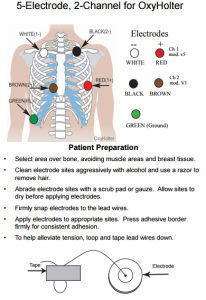Never Underestimate the Importance of a Great Hookup
It is impossible to over-estimate the importance of the hookup in obtaining a high quality Holter study.
Never has the adage “garbage in, garbage out” been more accurate. The critical physical connection between the recorder and the patient’s skin makes all the difference in the world. Even the best signal processing software in the world will struggle to extract meaning from data that is noisy, low amplitude, or full of artifacts.
Think about what we are really trying to do in an ambulatory study. We’re attempting to measure microvolts of signal from heart muscle — a signal that is traveling through several layers of varying density biological material in an environment of surrounding, larger signal muscle noise, physical motion, and an external environment of electrical noise of a completely uncontrolled and random nature. Frankly it is a testament to good engineering and signal processing that we derive anything useful whatsoever!
The components of a good hookup are as follows: 1. proper location, 2. proper skin prep, 3. proper supplies, and 4. proper technique and patient instruction.
-
Proper location — Three important aspects of a study are the same as the three critical factors in real estate: location, location, location. The body of work that technicians use to determine whether the heart is conducting properly is based on visualizations of the electrical signal from the heart as measured at specific spatial orientations around that important muscle. The proper location of the electrodes is paramount.
There are a set of standard locations on the body that yield the specific leads of information that EPs and CTs want to see. The hookup guides for NEMon recorders give those ELECTRODE locations and tell the analyst what ELECTRODE PAIRS correspond to which standardized LEADS.
For example, the 5-wire patient cable hookup diagrams show that the three CHs are:
CH1: RED/BROWN, CMS
CH2: RED/BLACK, aVF
CH3: WHITE/BLACK, lead IIHowever, when using the 7-wire patient cables, the three CHs are:
CH1: WHITE/RED, mod V5
CH2: BLACK/BROWN, mod V1
CH3: BLUE/ORANGE, lead III - Proper skin prep — Skin can be prepared to better propagate the tiny electrical signals that arrive at surface level. Preparation may involve shaving, cleaning, slight abrasion, and the use of conductive gels. The signals are affected less by induced artifact (muscle movement noise) when the resistance is lower. Proper skin prep can reduce the value from 4M-ohms to 1.2K-ohm, a 3000-to-1 reduction! (See “Techniques for Monitoring the Ambulatory Patient,” by Dan Walton, or request a reprint of that white paper.)
- Proper supplies — A hookup kit should include the supplies to make the technician’s job easier. At a minimum, those items should include
- a disposable razor
- an alcohol cleansing pad
- an abrasive pad
- conductive gel
- the proper number of electrodes
NEMon and many other sources offer hookup kits to their customers. They are best purchased to minimize shelf storage time since many of the items in the kits have finite shelf-lives, including the fresh recorder batteries we add to our kits! Here are links to our most popular hookup kits, the 5- and 7-wire DR200/HE hook-up kits from the NEMonStore online:
http://www.mcssl.com/store/northeastmonitoringinc/dr200e-hook-up-kit-5-electrodes
http://www.mcssl.com/store/northeastmonitoringinc/dr200he-hook-up-kit-7-electrodes
-
Proper technique and patient instruction — If the electrodes fall off as the patient leaves the clinic, the study is doomed. If the study is to be a long term or multi-day study, and the patient takes a shower and the electrodes fall off — again, not a good outcome. Be sure to instruct the patient how and where to properly replace electrodes, perhaps even including the strain relief loop technique.
If the patient is not capable of replacing the electrodes themselves, make sure they understand that it is best to return to the office to get help as soon as is practical.
Just as in so many other areas of life, the first connection is the most important. With a good hookup, you’ll get the data you need to recommend the best treatments for your patient.
[cta]Is your monitoring system outdated? Contact NEMon to learn more about the outstanding value our Holter products offer — by email at info@nemon.com, or call us toll-free at 866-346-5837 option 2 or 978-461-3992.[/cta]


